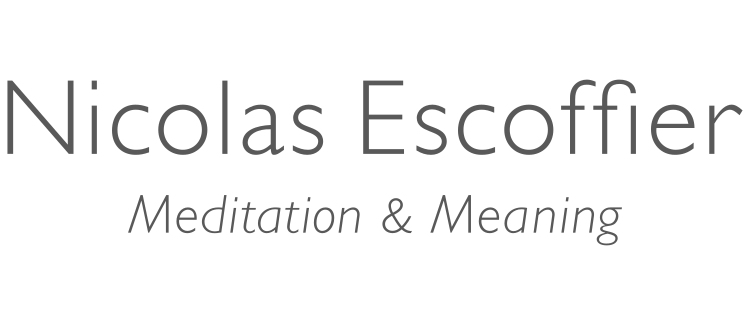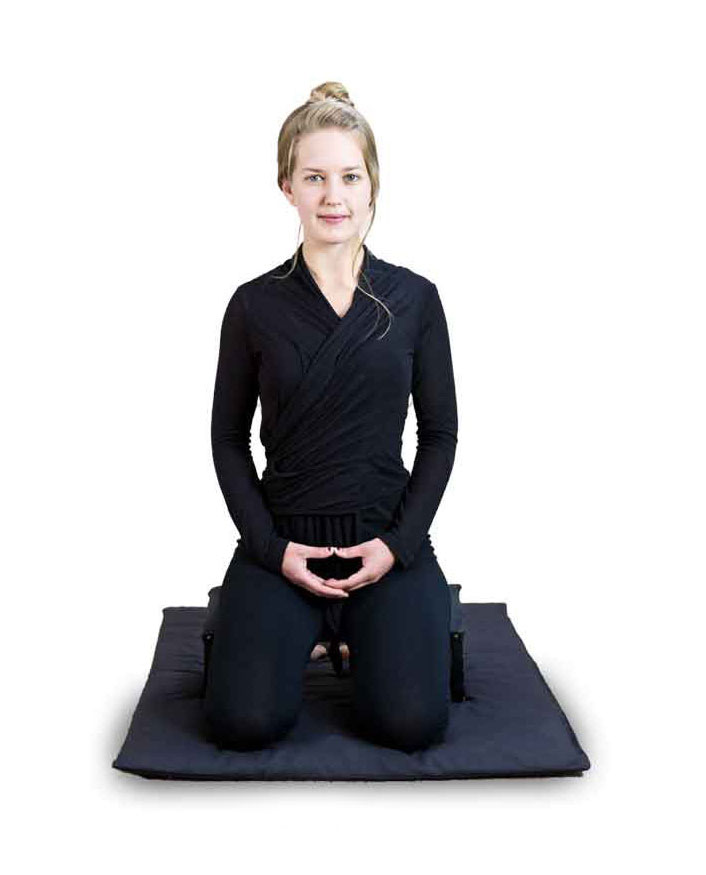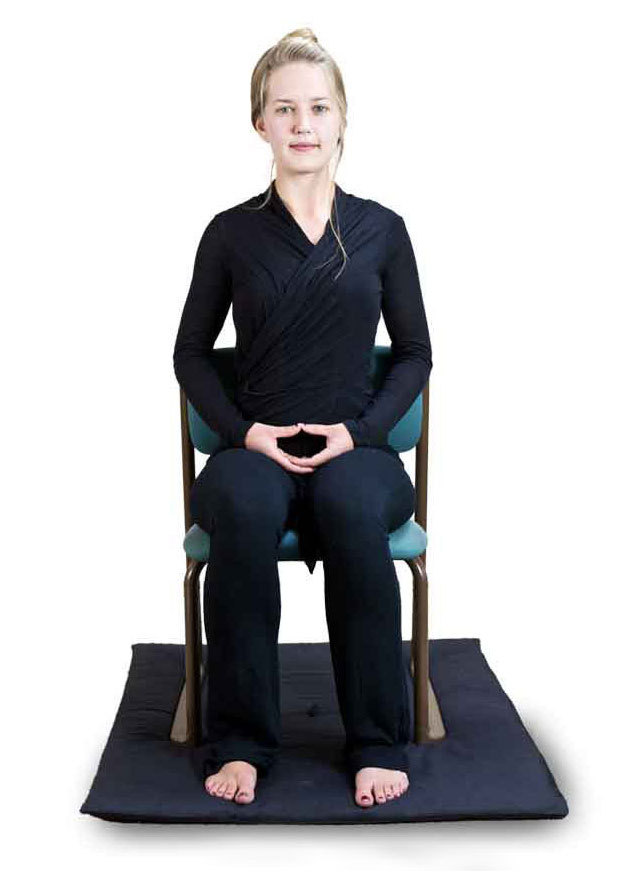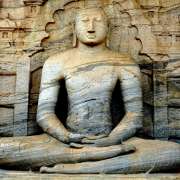Practice
The importance of posture in meditation
It is impossible to overstate the benefits that finding the best meditation position can bring to our meditation practice. The right posture can transform our minds by deepening relaxation and clarity. It can limit pain, discomfort, and reduce the risk of injury during long retreats. It helps enhance body awareness with a direct impact on our emotional lives. It allows us to explore and expand our understanding of the relationships between our body and our mind. Working with our meditation position can be a full spiritual path.
In the following, you will learn the principles behind a good meditation posture, the advantages of different poses, and ways to solve meditation problems with posture. You will gain the foundations to make your own experiments and discoveries and find the best meditation positions for your practice. Let’s start!
Two goals for your best meditation position
A good meditation posture is a posture that offers the best conditions for meditation. Meditation is a discipline of the mind, but it also engages the body in its complex interactions with our inner life. A suitable position for meditation must benefit both body and mind.
It must help us achieve these two objectives:
- A relaxed body
- An alert mind
A good posture will allow us to optimize these two qualities simultaneously, and it will be important to keep these two objectives in mind as we experiment with different meditation position and poses.
Three types of positions are commonly used for meditation: sitting, standing, and lying down. Walking meditation is another option, but it is such a rich topic that it deserves its own article. In what follows we will spend more time on the sitting posture, but will start with the lying down meditation position and the standing meditation stance which are important alternatives.
Standing and lying down meditation postures: alternatives to sitting meditations positions
While they are less popular than seated meditation positions, standing and lying down meditations play an important role in meditation. They can help you develop new directions in your practice and can help control pain or drowsiness when a sitting meditation position hurts or is too uncomfortable.
Lying down: the best meditation position?
A comfortable position, but not without issues
Lying down meditation positions would appear to be an excellent choice for meditation. They are comfortable, take no time to master, and can be maintained for a long time without fatigue. They are also an excellent solution for people who suffer from back or leg pain during sitting meditation. In short, they are the ideal posture for the body.
In meditation, however, the effect of posture on the mind is equally important: we must be able to stay alert. Unfortunately, it is not the strong point of lying down meditation poses. Because they are the positions we adopt while sleeping and resting, they can easily make the mind drift towards thoughts, drowsiness, and sleep. We should therefore avoid these meditation positions when we are tired. And even when we feel alert, we should make the adjustments I describe below so that we can reduce the risk of falling asleep.
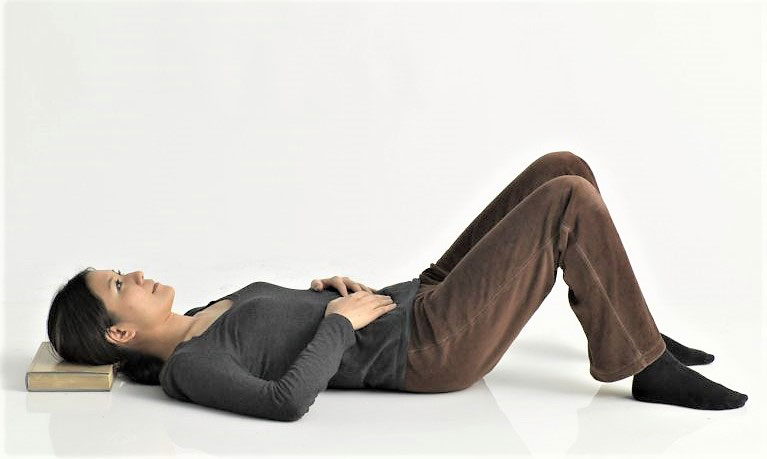
Adjustments: avoiding drowsiness when meditating lying down
When meditating lying down on the back, raise the knees and point them at the sky, bent at about 90 degrees, with feet kept flat on the support. This creates a slight tension in the hips, which helps keep a physical engagement in the meditation pose. You can additionally keep the legs parallel to each other with space between the knees. If you drift toward sleep your legs will slide to the side, which will wake you up.
Lying down on the side is another choice for lying doing position, in fact it is a more traditional one, but is best used when you are alert because it is more difficult to adjust to prevent sleepiness.
The standing meditation posture
When to meditate standing up
The standing meditation stance might appear an odd choice for meditation. It might seem too uncomfortable to help in our meditation practice. It has two significant advantages, however. First, it is a good choice when we are tired. When we meditate standing, we have no choice but to stay alert. Second, it can help bring meditative states into daily activities. As we meditate standing up, we learn to stay present and relaxed despite the physical engagement required by the position. This make it easier to access these same meditative qualities of presence and relaxation when walking and standing in daily life. This transforms these everyday moments into opportunities for practice and, over time, the spontaneous emergence of meditative states in daily life.
Meditating standing up can also help cultivate our sensitivity to the body, which is a deep and rewarding path. For example, some forms of qi gong, the Chinese discipline of cultivation of body and mind, involve standing postures held for long periods of time with proven health benefits.
Adjustments: keep sessions short
At the beginning, only keep standing up meditation poses for a few minutes. Stop as soon as you experience excessive discomfort. Holding this position takes effort, which can make the mind restless. With time, however, your muscles and motor systems will get used to meditating in this position, and you will be able to hold it for longer periods while maintaining the mind at ease.
Other suggestions for adjustments to this posture are similar to those of the sitting meditation posture and are presented below.
The sitting meditation position: a perfect balance
The sitting meditation posture is the most frequently used and might be the best meditation position. Why? It is an excellent compromise between lying down and standing positions, as it allows both relaxation and alertness. Because the torso is kept upright, we avoid drowsiness, and the mind stays alert. Because the legs and hips can relax, we experience less fatigue and tension, which leaves our attention available to work on the mind.
There is a wide variety of sitting meditation positions to experiment with, and you are likely to find one that will work for you. I list the most common below.
A glimpse into your inner journey: take the test
Find out how your personality changes your meditation journey with the free test based on recent research.
The lotus or half-lotus positions
It is a classic, notably in as Buddhist meditation posture. It is considered in some traditions as the best meditation position. However, it is only one posture among many and must be approached with caution, first because it demands great flexibility, and second it can present risk of injuries for our body. For these reasons it is the foundation for the seven point posture of the Buddhist tradition.
Pros: the placement of feet on the thighs locks the legs in their folded position, which holds the lower back still with limited muscular effort. This allows for a relaxed seated meditation position even on a horizontal support. It also places the spine in an ideal position for certain meditative and bodily practices such as pranayama breathing.
Cons: the full lotus posture require a lot of flexibility and is accessible to a few of us. The half-lotus can be a suitable alternative with similar advantages and less demand on our bodies. In particular, the lotus position is not without risk and can cause pain and hurt to the knees and hips.
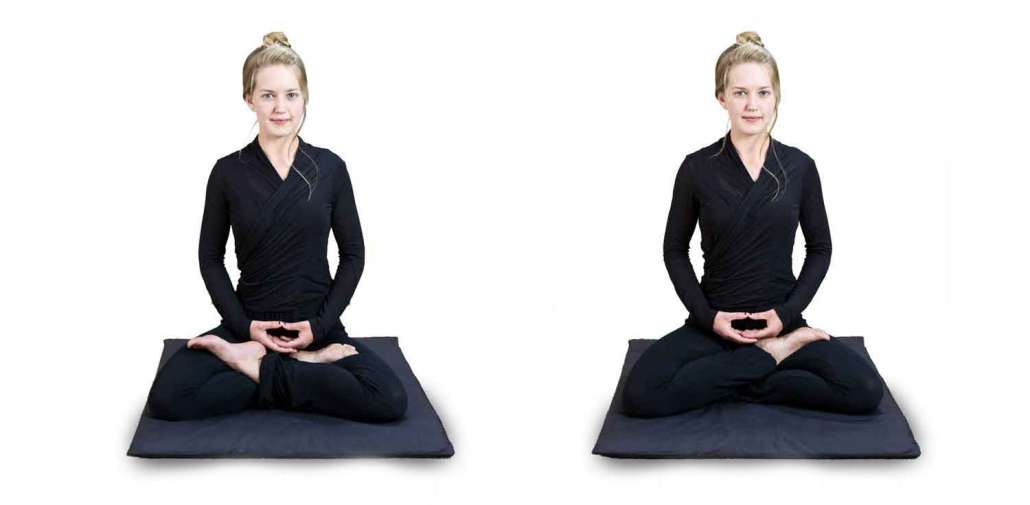
The quarter lotus posture and the Burmese position
These two meditation positions are easier than the lotus position. They place the feet lower, or, for the Burmese posture, flat on the ground, which relieves the knees and prevent them from hurting.
Pros: in the quarter lotus pose, the position of the legs blocks the lower back to some extent. In both postures, part of the body weight is distributed on the knees, which provides stability without requiring flexibility.
Cons: These two meditation positions do not offer as good of a support for the back as the two previous lotus postures. It will be important to choose a seat wisely to compensate (read more about the seat further down).
The Japanese seiza sitting position
A traditional Japanese sitting posture, also used in martial arts or tea ceremony.
Pros: a comfortable meditation position, when used with an adequate support that relieves the pressure on the legs while maintaining the hips in a relaxed stance.
Cons: for people with weak knees or ankles, this posture can sometimes be uncomfortable. The Burmese posture is an alternative.
Meditating seated on a chair
A good choice when other meditation positions are too uncomfortable, and when we are traveling.
Pros: a posture our body is used to, comfortable and well suited to meditation. When meditating seated, seat toward the edge of the seat or chair and avoid leaning on the backrest.
Cons: it can create excessive tension in the hip flexors muscles and the thighs. To avoid this, use a seat that is high enough, or use cushions, to keep the thighs horizontal or slightly tilted downward.
Why your seat matters : the foundation for a good meditation
The most important point for sitting meditation is the quality of the seat. There are many options, but you need to make sure that the support you choose meets the conditions below:
- It allows legs to be positioned to limit the risks of postural discomfort and pain. Choose a support that fits the posture that works best for you. For example, for a japanese seiza meditation position, a meditation bench may be more suitable than a cushion.
- It is high enough to keep your knees lower than your seating bone at the base of the hips. This is an important point. The position of the hips is essential for meditation but is often overlooked. When the pelvis is higher than the knees, it remains balanced without tilting forward or backward. This balance prevents the lumbar spine from arching and relaxes the hip muscles that keep the lower back straight. The spine is then better aligned and the posture can stay relaxed, which will limit back pain and benefit the rest of the body and your meditation.
- It should be comfortable and let the blood flow unimpeded through the buttocks and legs to prevent your legs from becoming stiff while meditating. If you find a support that works for you but is too firm, you can add a memory foam pad to soften it. Seating closer to the edge of the seat can also prevents legs from going to sleep by freeing the underside of the thighs.
- It is compact and transportable. That is a bonus. For practitioners of all levels, it is a challenge to sustain a regular meditation practice. Having a support that follows you during travels will help you stay consistent in your meditation. A transportable support can also follow you during meditation retreats and will help you adjust with greater ease to the unfamiliar setting.

Problems and pain in meditation: working with your meditation position
The biggest physical challenges in meditation, such as pain in the back, hips or knees, or stiff legs often have their source in our meditation position. This difficulties can be improved and sometimes fixed by trying out the suggestions presented below.
Even when we meditate at home without pain, working on our meditation position can be helpful. It help protect our body, make our meditation practice more sustainable, and can prepare us for the long hours of practice of a meditation retreat or a day-long meditation event.
As you try out these adjustments in your own practice, any changes you make to your current meditation posture should be subtle and gradual.
Hand position during meditation
The best hand position will prevent tension from building up in your arms during meditation. This will also limit tension in the back and prevent pain, especially if you have a bad back. A clue that your hand position while you meditate could be improved, is pain in the shoulders and between the shoulder blades.
Suggestions:
- Let your hands rest on your thighs. Try several locations moving down from the upper thighs until you find the most comfortable position. Check for tensions and strain in your shoulders and upper back as you experiment with hand position.
- Place your hands near the lower belly, below the navel. In a lotus meditation position, hands can rest on your feet. In other postures, they can rest on a small cushion placed between the legs or on a shawl covering the thighs. Hands can be left palm up or down, but always with relaxed palms.
- When meditating standing up, pressing the hands lightly near the lower belly may help reduce tension if shoulders and back hurt. Otherwise let them hang at your side. When meditating lying down, they can rest on your chest, solar plexus, or lower belly.
The mouth
Your mouth can stay closed or be slightly open and should stay relaxed. Make sure that your jaw rests loosely.
Stiff meditation position
We are never relaxed enough when meditating. Before and during your meditation, check whether tensions are present in the body and release any you might find. If helpful, try to visualize or sense your breath traveling through and relaxing the tense areas. If you experience recurring tension, check your posture, and consider practicing using relaxation techniques such as body scans or gently yoga poses or stretches before you start meditating.
Excessive movement while meditating
While we must sometimes move to relieve discomfort during meditation, seeking stillness has many advantages. Our focus should be to work toward a natural and relaxed stillness. You should avoid stiffening up when trying to prevent movement. When you must move always stay aware before, during and after the movement and try to stay gentle and relaxed throughout.
Alignment of the spine
Keep the spine in its natural alignment during meditation, without tension, to respect its natural curves. Ancient texts suggest abandoning our spine like a stack of coins. It may also be helpful to imagine, feel, or sense a light vertical pull or buoyancy in the torso. It might be easier to sense near or at the spine.
Tensions in the arms
Tension in the arms often leads to back pain while meditating, usually near the shoulder blades. To relieve your back, leave some space between your arms and chest, seeking a sensation of openness under the armpits. Also, make sure your hands can rest on a support, as discussed above.
Forward push of the head
Many meditators, even experienced ones, keep their heads too far forward. This creates tension in the neck and arch the shoulders, which prevents relaxation of the torso, complicates breathing and impedes somatic awareness at the chest and head area. Keep your head in natural alignment with the spine during meditation. You can tuck in your chin slightly to get a feeling of back of the neck being pulled up. To avoid over-correcting and pushing backward too much, imagine that your head is lifted towards the sky.
Lifted shoulders
Some meditators lift their shoulders in search for vertical alignment while they meditate. Let the shoulders fall back casually into a natural position in order to keep your meditation posture relaxed.
The path to our personal meditation position
Finding the best meditation position for us and allowing it to change is a path. From the corrections we make as a beginner to avoid discomfort, our posture keeps evolving with the challenges and breakthroughs we face in our meditation. Our meditation position can be shaped by our own experimentations, advices received by more advanced practitioners, or traditional meditation poses such as the posture of the Vairocana buddha. Over time, our position during meditation becomes a reflection of our personal path as it embodies the strengths and depth of our approach to meditation and life.
